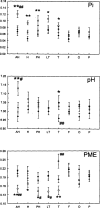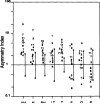Regional distribution of interictal 31P metabolic changes in patients with temporal lobe epilepsy
- PMID: 9596206
- PMCID: PMC2735262
- DOI: 10.1111/j.1528-1157.1998.tb01416.x
Regional distribution of interictal 31P metabolic changes in patients with temporal lobe epilepsy
Abstract
Purpose: We compared the 31P metabolites in different brain regions of patients with temporal lobe epilepsy (TLE) with those from controls.
Methods: Ten control subjects and 11 patients with TLE were investigated with magnetic resonance imaging (MRI) and [31P]MR spectroscopic imaging (MRSI). [31P]MR spectra were selected from a variety of brain regions inside and outside the temporal lobe.
Results: There were no asymmetries of inorganic phosphate (Pi), pH, or phosphomonoesters (PME) between regions in the left and right hemispheres of controls. In patients with TLE, Pi and pH were higher and PME was lower throughout the entire ipsilateral temporal lobe as compared with the contralateral side and there were no significant asymmetries outside the temporal lobe. The degree of ipsilateral/contralateral asymmetry for all three metabolites was substantially greater for the temporal lobe than for the frontal, occipital, and parietal lobes, and these asymmetries provided additional data for seizure localization. As compared with levels in controls, Pi and pH were increased and PME were decreased on the ipsilateral side in patients with TLE. There were changes in Pi, pH, and PME on the contralateral side in persons with epilepsy as compared with controls, contrary to changes on the ipsilateral side.
Conclusions: Our findings provide some insight into the metabolic changes that occur in TLE and may prove useful adjuncts for seizure focus lateralization or localization.
Figures



Similar articles
-
Lateralization of human temporal lobe epilepsy by 31P NMR spectroscopic imaging at 4.1 T.Neurology. 1998 Aug;51(2):472-9. doi: 10.1212/wnl.51.2.472. Neurology. 1998. PMID: 9710021
-
Increased pH and inorganic phosphate in temporal seizure foci demonstrated by [31P]MRS.Epilepsia. 1992 Jul-Aug;33(4):618-23. doi: 10.1111/j.1528-1157.1992.tb02337.x. Epilepsia. 1992. PMID: 1628574
-
Clinical applications of magnetic resonance spectroscopy.Epilepsia. 1997;38 Suppl 4:S13-7. doi: 10.1111/j.1528-1157.1997.tb04534.x. Epilepsia. 1997. PMID: 9240236 Review.
-
Ipsilateral and contralateral MRI volumetric abnormalities in chronic unilateral temporal lobe epilepsy and their clinical correlates.Epilepsia. 2005 Mar;46(3):420-30. doi: 10.1111/j.0013-9580.2005.27004.x. Epilepsia. 2005. PMID: 15730540
-
Application of spectroscopic imaging in epilepsy.Magn Reson Imaging. 1995;13(8):1181-5. doi: 10.1016/0730-725x(95)02030-w. Magn Reson Imaging. 1995. PMID: 8750334 Review.
Cited by
-
Evidence of neuronal injury outside the medial temporal lobe in temporal lobe epilepsy: N-acetylaspartate concentration reductions detected with multisection proton MR spectroscopic imaging--initial experience.Radiology. 2003 Jan;226(1):195-202. doi: 10.1148/radiol.2261011668. Radiology. 2003. PMID: 12511690 Free PMC article.
-
3D 31 P MR spectroscopic imaging of the human brain at 3 T with a 31 P receive array: An assessment of 1 H decoupling, T1 relaxation times, 1 H-31 P nuclear Overhauser effects and NAD.NMR Biomed. 2021 May;34(5):e4169. doi: 10.1002/nbm.4169. Epub 2019 Sep 13. NMR Biomed. 2021. PMID: 31518036 Free PMC article.
-
7 Tesla and Beyond: Advanced Methods and Clinical Applications in Magnetic Resonance Imaging.Invest Radiol. 2021 Nov 1;56(11):705-725. doi: 10.1097/RLI.0000000000000820. Invest Radiol. 2021. PMID: 34510098 Free PMC article. Review.
-
Modulatory effects of neuropsychopharmaca on intracellular pH of hippocampal neurones in vitro.Br J Pharmacol. 2010 Jan 1;159(2):474-83. doi: 10.1111/j.1476-5381.2009.00540.x. Epub 2009 Dec 10. Br J Pharmacol. 2010. PMID: 20015293 Free PMC article.
-
PH Measurements of the Brain Using Phosphorus Magnetic Resonance Spectroscopy ((31)PMRS) in Healthy Men - Comparison of Two Analysis Methods.Pol J Radiol. 2015 Nov 21;80:509-14. doi: 10.12659/PJR.895178. eCollection 2015. Pol J Radiol. 2015. PMID: 26692912 Free PMC article.
References
-
- Scheuer ML, Pedley TA. The evaluation and treatment of seizures. N Engl J Med. 1990;323:1468–74. - PubMed
-
- Babb TL, Brown WJ. Pathological findings in epilepsy. In: Engel J Jr, editor. Surgical treatment of the epilepsies. Raven Press; New York: 1987. pp. 511–70.
-
- Jackson GD, Berkovic SF, Tress BM, et al. Hippocampal sclerosis can be reliably detected by magnetic resonance imaging. Neurology. 1990;40:1869–75. - PubMed
-
- Berkovich SF, Andermann F, Ethier R, et al. Hippocampal sclerosis in temporal lobe epilepsy demonstrated by magnetic resonance imaging. Ann Neurol. 1991;29:175–82. - PubMed
-
- Heinz ER, Crain BJ, Radtke RA, et al. MR Imaging in patients with temporal lobe seizures: correlation of results with pathologic findings. AJR. 1990;155:581–6. - PubMed
Publication types
MeSH terms
Substances
Grants and funding
LinkOut - more resources
Full Text Sources
Research Materials
Miscellaneous

